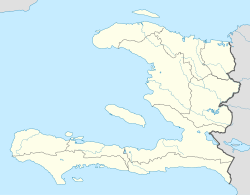Fort-Liberté
Fort-Liberté
(Kréyòl): Fòlibète | |
|---|---|
 Fort Dauphin from the North. | |
| Coordinates: 19°40′4″N 71°50′23″W / 19.66778°N 71.83972°W | |
| Country | Haiti |
| Département | Nord-Est |
| Arrondisement | Fort-Liberté |
| Founded | 1578 |
| Population (2003) | |
| • Total | 30,110 |
| • Demonym | Fort-Dauphinois (female Fort-Dauphinoise |
| Time zone | UTC-5 (Eastern) |
| • Summer (DST) | UTC-4 (Eastern) |
Fort-Liberté (Kréyòl: Fòlibète; English: "Fort Liberty") is a city in northeast Haiti, on the Atlantic coast. It is the capital city of the Nord-Est Département.
The city is on the Baie de Fort-Liberté ("Fort-Liberté Bay") about 56 km east of Cap-Haïtien and to the west of the Dominican Republic. It is also the chief town of an arrondissement (a part of a department) with the same name. The arrondissement has three communes (a commune is like a municipality): Fort-Liberté, Ferrier (Kreyòl: Ferye) and Perches (Kreyòl: Opèch).
History[change | change source]
Between 1503 and 1505, Nicolás de Ovando, Spanish governor of the Hispaniola, founded the town of Puerto Real (English, "Royal Port") where is the present town of "Caracol", to the west of Fort-Liberté.[1] But soon this town was abandoned and the people moved to the east, founding in 1578 a new town with the Taíno name of the region: Bayajá.
In 1606, those persons living in the old Spanish towns of Bayajá and Yaguana had, by orders of the Spanish king, to move to the eastern part of the island, to a new town called Bayaguana, combining the two old names.[2]
Later, when French people founded a new town in this place, they called it Fort-Dauphin in 1731, named after the "Dauphin" (the "Dolphin", son of the French king Louis XV). When the French Republic was founded, the name was changed to Fort-Liberté in 1792. After Henri Christophe became King Henri I of Haiti in 1811, he renamed the city Fort-Royal. In 1820, after the death of Christophe, the name was changed back to Fort Liberté.
Forts around Fort-Liberté[change | change source]
There are several forts built around the bay. An important one is Fort Dauphin, sometimes called Fort Saint Joseph (Patron Saint of the city) or Fort Liberté. Other forts in the area are Fort de la Bouque, Batterie de l'Anse, Fort Saint Charles and Fort Saint Frédérique.
Economy[change | change source]
Fort-Liberté has a small port that also receives international products and serves as a fishing port. Local agricultural products include sugarcane and citrus fruits.
Media[change | change source]
Radio[change | change source]
- Radio Gamma FM, 99.7 MHz, 26, Ave Sténio Vincent, Fort-Liberté, www.gammafmhaiti.net
- La Voix Evangélique du Nord-Est, 100.9 MHz, www.venhaiti.net
- Radio Dauphin FM
- Radyo Kominotè Nòdès
- Radio Parole de Vie
References[change | change source]
- ↑ de Saint-Méry, M.L.E. Moreau (1797–1798). Description topographique, physique, civile, politique et historique de la partie française de l'isle Saint-Domingue (in French). Philadelphia, Paris, Hamburg.
- ↑ Moya Pons, Frank (1977). Manual de Historia Dominicana (in Spanish). Santiago: UCMM. p. 59.
Other websites[change | change source]
- Haïti Référence: Profil de la Ville du Fort Liberté Archived 2007-08-06 at the Wayback Machine - Information on Fort Liberté (French text).
| Department capitals of Haiti | |
|---|---|
| Cap-Haïtien • Fort-Liberté • Gonaïves • Hinche • Jacmel • Jérémie • Les Cayes • Miragoâne • Port-au-Prince • Port-de-Paix | |

